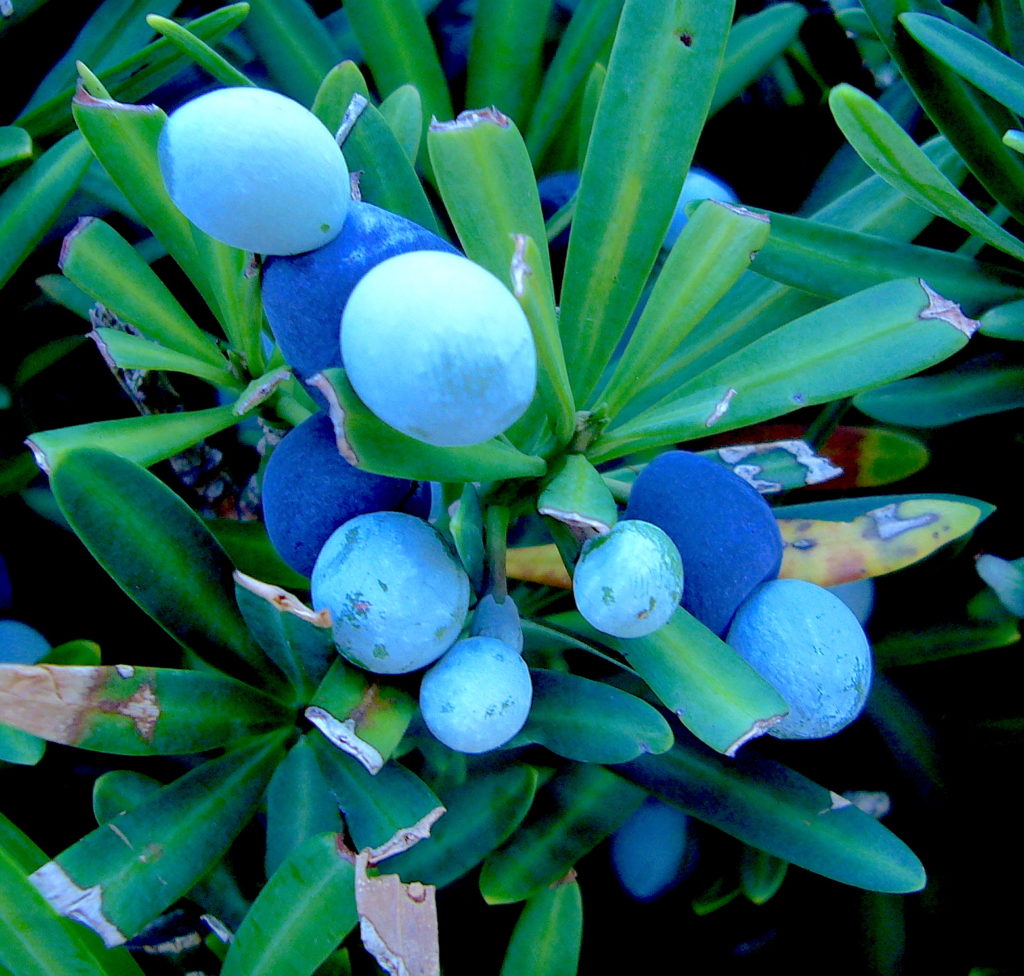
Podocarpus arils, the dark blue parts, are ripening. The powder blue seeds on the ends are not edible. Story below. Photo by Green Deane
Botany is strange in that sometimes a scientific name actually will be relevant to the plant. Other times it will not. Coronopus didymus is a good example. It describes Swinecress well. Sometimes names will not only be wrong: Pinus palustris is a pine that does not grow in swamps despite its name suggesting so. And the names can be meaningless. This happens when a plant’s genus and species names are two botanists last names as in Mahonia swaseyi. No information shared there. Common names can also be confusing. While in theory all plants have only one botanical name they can have dozens of common names. There are at least 18 “pigweeds” in North America and nearly as many “Indian Potatoes.” Some of those pigweeds and Indian Potatoes are edible and some of them are toxic. Barnyard Grass, which is edible, is one of those plant names that misses the mark.
One would think that with a name like “Barnyard Grass” one would find it in barnyards. But no. It is probably safe to say you will rarely find Barnyard Grass in a barnyard. Why? Because Barnyard Grass likes to grow in water, lots of water. You can easily find it in ponds, streams and drainage ditches but not barnyards unless it is growing directly under the roof drain spout in a very low, wet spot. In all my years of foraging I have seen Barnyard Grass once in a barnyard but dozens of times in water. In wet areas look for a tall grass that resembles wheat. The stems will be hairy and usually purple at the base. One easy place to find them locally is in dried up lakes. Often at the still-damp low spot Barnyard Grass will colonize the entire wet spot. Not a native it comes in season at the same time and one can find it seeding now. The grain is a bit more coarse than wheat but can be harvested, prepared and used the same way. You can read about Barnyard Grass here.
Also just beginning to fruit is a species that is very invasive in some areas: The Strawberry Guava. During the foraging class this past Sunday we spent extra class time walking through a local neighborhood. We found several edibles, among them the Strawberry Guava. I had one in my yard for about 15 years. Not only are the fruit edible but the dried leaves can be made into a passable tea. One does, however, need to know a little about the species to make the most of the fruit. It’s a little smaller than a ping-pong ball, has tough seeds, and starts out green and hard. As it ripens and softens it will get shades of pink, yellow and red and eventually become dark red and soft, hence the name “Strawberry Guava.” The fruit is tart and sweet, more tart when young, more sweet when older. Despite the name I never tasted a strawberry flavor in any of the fruit. The problem is unless you spray the tree with insecticides the ripe fruit will be full of fly larvae (which you can also view as free protein.) When the fruit is just starting to turn from green to red the rind is too hard for the flies to lay eggs through. But by the time they are soft and ripe they are prime breeding ground. Thus you have a choice, slightly ripe and tart but bug free, or, very ripe and sweet and squirming. To read more about the Strawberry Guava go here.
Also ripening, perhaps a little early, are Podocarpus arils. The Podocarpus is a very common hedge plant which if ignored will grow into a pine-sized tree. The seeds are mildly toxic (and on the end) but the ripe arils are very grape-like and can be used like grapes, eaten off the bush or made into jelly and wine et cetera. The seeds are listed as toxic but I know of an adult who ate two at one time and had no issue. That said, don’t eat the seeds. When the Podocarpus fruits can be something of a guess. Locally I look for them in August. We found some very nice ripe ones this past weekend in Sarasota which is 149 miles to the south. The fruit can last several weeks and are edible even when they begin to dry and look like raisins. Oddly, in a local park in downtown Winter Park, a few Podocarpus have escaped trimming and have grown into moderate-size trees. I have seen those fruit in December. You can read more about Podocarpus here.
Upcoming Foraging Classes: Most foraging classes are four hours long and several dozen edible species are identified and discussed. All of the topics covered above in today’s newsletter include edibles found during the foraging class last Sunday in Sarasota.
Sunday, July 17th, Wickham Park: 2500 Parkway Drive, Melbourne, FL 32935-2335, 9 a.m. Meet at the dog park inside the park.
Sunday, July 24th, Bayshore Live Oak Park, 2200 East Lake Road, Port Charlotte, FL. 9 a.m. We meet at the parking lot across the street from Ganyard Road
Sunday, July 31st, Blanchard Park, 10501 Jay Blanchard Trail, Orlando, FL 32817, 9 a.m. Meet next to the tennis courts.
Sunday, Aug. 7th, Florida State College, south campus, 11901 Beach Blvd., Jacksonville, 32246. 9 a.m. We meet in front of building “D.”
Sunday, Aug 14th, Jervey Gantt Recreation Complex, 2390 SE 36th Ave., Ocala, FL, 34471. 9 a.m. Meet in the parking lot north of the pool.
To read more about the classes go here.
Want to identify a plant? Perhaps you’re looking for a foraging reference? You might have a UFO, an Unidentified Flowering Object you want identified. On the Green Deane Forum we — including Green Deane and others from around the world — chat about foraging all year. And it’s not just about warm-weather plants or just North American flora. Many nations share common weeds so there’s a lot to talk about, such as the one to the left. There’s also more than weeds. The reference section has information for foraging around the world. There are also articles on food preservation, and forgotten skills from making bows to fermenting food. Recent topics include: Keeping our cells young, Apple-like fruit on a vine, Square stem and balls of flowers, Is the saw Palmetto supposed to be bitter? Is This A Young Dandelion? Looks Like A Thistle Flower. Mint? Is This A Gopher Apple? No Flower Too Wrong, Apple-Like Fruit, Pink-White Flowers At The Nodes, Field Plant, Woodland Perennial, Frilly Pink Blossom, Hopefully Groundnut. Bane of my Efforts. Tiny Hypericum. Snake Boots, Unidentified Cane Plant, Small Green, and Scrub Jays! You can join the forum by clicking on the button on the upper right hand side of this page.
All of Green Deane’s videos are available for free on You Tube. They do have ads on them so every time you watch a Green Deane video I get a quarter of one cent. Four views, one cent. Not exactly a large money-maker but it helps pays for the newsletter. If you want to see the videos without ads and some in lightly better quality you can order the DVD set. It is nine DVDs with 15 videos on each. Many people want their own copy of the videos or they have a slow service and its easier to order then to watch them on-line. They make a good gift for that forager you know. Individual videos can also be ordered. You can order them by clicking on the button on the top right of this page or you can go here.
This is Newsletter 216.
If you would like to donate to Eat The Weeds please click here.

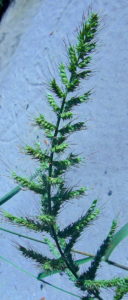
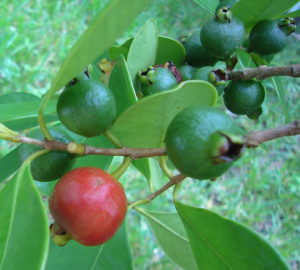
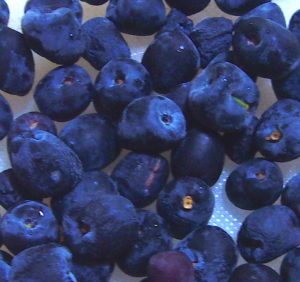
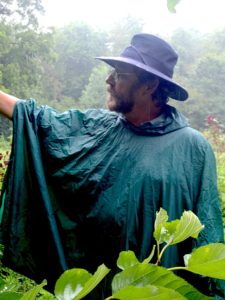
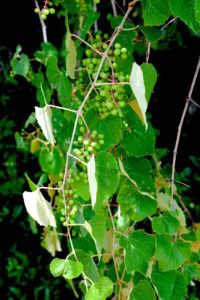
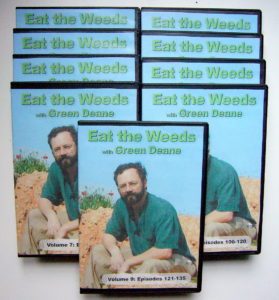

We had both the red and the yellow strawberry guavas growing on our North Florida homestead. They were hardier than I would have expected and I believe our location further north protected them from the fruit flies. We still lost some to squirrels, but boy… when fully ripe they were great.
Dean..I met you at Blanchard park and loved your knowledge. If I purchase your dvd set, is there a way I will be able to put them in my Itunes account so I can view while traveling from Iphone or Ipad.
I honestly don’t know. I am technologically challenged and haven’t any idea.
Actually… I have Itunes. Let me try importing one from a DVD. I’ll let you know.
I’ve witnessed Barnyard Grass since the late forties of last century when I was a child in Kasala Town – eastern Sudan. I remember my still intimate friend M. Ibraheem with sharp chisel (and brown donkey) cutting , collecting, “packing” the grass, and carrying it on the donkey back to the grass market to sell for few pennies, a shilling, or maximum two, quite sum enough for both of us to have dinner and enjoy a film in” El Shergeeya” – vernacular for eastern – Cinema.
Now, going through your article on Barnyard Grass and specially the Green Dean’s Itemised Plant Profile, I’m certain this is the plant of my concern. I’ve noticed black ants collecting their jelly like minute pale yellow spherical bodies – don’t know if they are eggs or some sort of food. They started moving these as soon as I began pulling the roots of some plants off the soil. I should like to thank you for the useful info. and to thank RM. Mc Williams for his comment concerning chemicals and the environment which I hope I may convey to a Sudanese friend of mine whose main responsibility and job has to with this important matter.